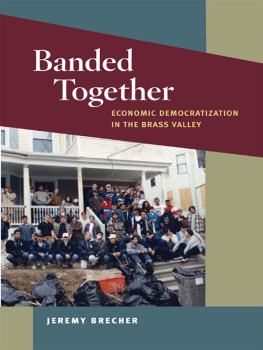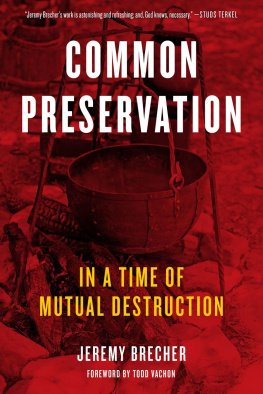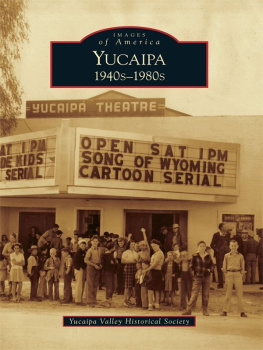Banded TogetherTHE WORKING CLASS IN AMERICAN HISTORY
Editorial Advisors
James R. Barrett
Alice Kessler-Harris
Nelson Lichtenstein
David Montgomery
A list of books in the series
appears at the end of this book.
Banded Together
Economic Democratization in the Brass Valley
JEREMY BRECHER
University of Illinois Press
URBANA, CHICAGO, AND SPRINGFIELD
2011 by the Board of Trustees of the University of Illinois
All rights reserved
Manufactured in the United States of America
1 2 3 4 5 C P 5 4 3 2 1

This book is printed on acid-free paper.
Library of Congress Cataloging-in-Publication Data
Brecher, Jeremy.
Banded together : economic democratization in the Brass Valley /
Jeremy Brecher.
p. cm. (The working class in American history)
Includes bibliographical references and index.
ISBN-13: 978-0-252-03612-5 (hardcover : alk. paper)
ISBN-10: 0-252-03612-3 (hardcover : alk. paper)
ISBN-13: 978-0-252-07806-4 (pbk. : alk. paper)
ISBN-10: 0-252-07806-3 (pbk. : alk. paper)
1. Social actionConnecticutNaugatuck River Valley. 2. DeindustrializationConnecticutNaugatuck River ValleyHistory. 3. Naugatuck River Valley (Conn.)Social conditions. 4. Naugatuck River Valley (Conn.)Economic conditions. 5. Brass Workers History Project. I. Title.
HN17.5.B713 2011
330.9746'1dc22 2010040244
This book is dedicated to the people of the Naugatuck Valley, who have educated me, sustained me, and taken me unto them as their pet outsider. I can truly say of the valley, as Herman Melvilles Ishmael said of his whale ship, that it has been my Yale College and my Harvard.
If all the people in a city are banded together to make it a better place to live, then it will be a better place to live. Thats what the Naugatuck Valley Project is all about.
Theresa Francis
Contents
Prologue
On a dreary day in April 1983, a hearse rolled through the little town of Thomaston in western Connecticuts Naugatuck Valley. Behind the hearse, four white-gloved factory workers carried a bier. On it was laid out a clocka Royal Seth mantel clock manufactured by the Seth Thomas Clock Company. The procession halted at the green next to the 168-year-old Seth Thomas factory. Then laid-off workers from Seth Thomas stuffed the clock with paper towels, soaked it with gasoline, and set it ablaze. They announced they would send the ashes to executives of Talley Industries, a multinational conglomerate that had bought Seth Thomas and then, unexpectedly, shut it down forever.
Seth Thomas was not just a business; it was the basis for a way of life that typified industrial communities throughout America. For generations, local girls and boys had grown up expecting to work at the Seth Thomas Clock Company or the Plume and Atwood mill that Thomas had founded to supply his clock company with brass. Thomaston schoolchildren chanted:
Ashes to ashes
Dust to dust
If Seth Thomas doesnt get you
Plume & Atwood must.
When Talley decided to close Seth Thomas, those who worked there were among the last to find out. Mary Tycenski, whose family had worked at Seth Thomas for many decades, recalls that one afternoon in 1982, We were working and they just called a meeting. One of the executives from Talley Industries was there. He just said they were closing Seth Thomas down and moving to Georgia. Just everybody felt just terrible. It was a shock.
According to the local union president, Seth Thomass ninety-two laid-off union members had together given 1,450 years of service to the company. The plants closing left many of them facing long-term unemployment.
The closing also left a wound in the communitys identity. Matthew Monahan, Thomaston postmaster and a former Seth Thomas employee, said, It just seemed as though Seth Thomas was Thomaston. If you ever travel anywhere in the Navy or anywhere, they might not know where Thomaston was, but if you mention Seth Thomas clocks, they all had a Seth Thomas clock in their home. The Navy ships had Seth Thomas clocks. Even in Japan I saw Seth Thomas clocks. They were known throughout the world. Francis Kane, a retired Seth Thomas employee, said, I figured Seth Thomas really belongs to Thomaston; thats where it originated.
The demise of Seth Thomas was only one of dozens of plant closings that were decimating the clock, brass, rubber, and other industries of the Naugatuck Valley in the early 1980sand only one of thousands occurring throughout industrial America. Deindustrialization was devastating life in the valley, but there was little effort to do anything about it. The reason was simple: a sense of utter powerlessness in the face of forces and decisions over which people in local communities had virtually no control.
It was that bitter feeling of powerlessness Seth Thomas workers sought to express by holding a funeral and cremating a clock. Former Seth Thomas employee Linda Turner called it a symbolic gesture of ordinary people against something they cannot change. In a eulogy for the clock, Rev. Henry Cody of St. Thomas Parish in Thomaston said, We mourn for the workers who served with dedication, loyalty, and skill. We ask for a resurrection here, that people may again have a chance to create.
Acknowledgments
Hundreds of people have helped me on this project in one way or another over the past quarter century; I thank them all. I would like to acknowledge the leaders, staff, and participants in the Naugatuck Valley Project (NVP) who helped me with this work over the years, including Ken Galdston, Carol Burkhart-Lyons, Barbara Therrien, Theresa Francis, Janet Caggiano, and Rev. Elizabeth Rosa. Thanks also to the more than one hundred people who let me interview them for this research and the hundreds more who have let me interview them for other aspects of my research in the Naugatuck Valley.
I received help with the chapters on ValleyCare from Ruth Glasser and with the chapter on Brookside from Lucien Lafreniere. Among those who introduced me to the valley were Peter and Frances Marcuse, who have supported my involvement ever since, and my first valley collaborators, Jerry Lombardi and the late Jan Stackhouse.
The Mattatuck Museum has provided me a base for thirty years of research in the Naugatuck Valley and specifically helped with archiving my NVP materials and participating in the 2009 NVP History Project; I would like to acknowledge in particular Ann Smith, Marie Galbraith, Suzie Fateh, and Cynthia Roznoy. Sister Marie Michaud and another volunteer who has requested to remain anonymous made an enormous contribution by transcribing many of the interviews used in this book.
I would also like to thank those who have given me comments on all or part of the book, including Ken Galdston, Carol Burkhart-Lyons, Ruth Glasser, Jill Cutler, Charles Hotchkiss, and Peter Rachleff.
I would like to thank the Cooperative Charitable Trust, which nurtured the initial research project that gave birth to this book and provided support to finish it. I would also like to thank the members of the Cooperative Charitable Trust Forum, who individually and collectively provided a great deal of my knowledge and understanding of all matters connected with cooperatives and employee ownership as well as commentary on the original studies that resulted in this book. This project was also made possible by support provided to related work by the Connecticut Humanities Council, the Catholic Communications Campaign, the Ford Foundation, and the National Endowment for the Humanities.







 This book is printed on acid-free paper.
This book is printed on acid-free paper.